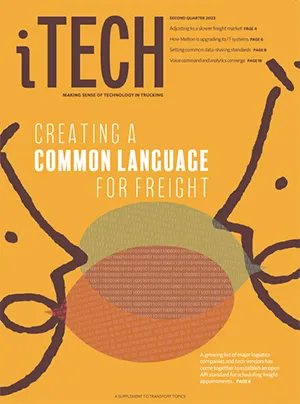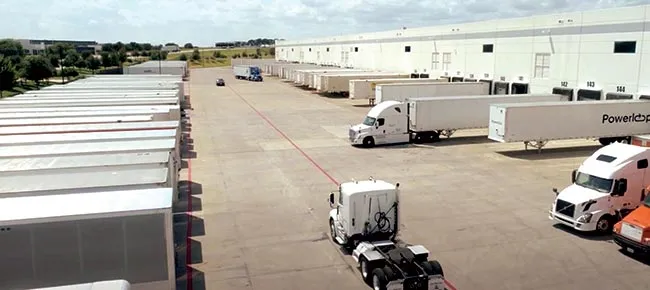Logistics Providers Work to Set Freight Scheduling Standards

[Find the latest in trucking technology: Explore this quarter's issue of iTECH]
Freight transportation is a fragmented industry whose players should collaborate to overcome entrenched inefficiencies. That is the message from major logistics companies and technology providers that have joined forces to alleviate a particular pain point hampering the industry — the making, keeping and adjusting of freight appointments.
“All of us have heard from our customers about the inefficiencies” at the dock level, and “opportunities to become more efficient,” said Spencer Frazier, executive vice president of sales and marketing at J.B. Hunt Transport Services.
The trucking and intermodal logistics company joined third-party logistics providers Convoy and Uber Freight in December to form the Scheduling Standards Consortium, which aims to establish industry standards for sharing scheduling information among shippers, freight brokers and carriers.
The consortium announced earlier this month that seven more companies have joined the group, including both 3PLs and transportation management system vendors. The new members are logistics providers Arrive Logistics, Coyote Logistics and Echo Global Logistics, and supply chain technology companies Blue Yonder, e2open, One Network Enterprises and Oracle.
The addition of the new members signaled momentum for the project, said Frazier, Convoy CEO and co-founder Dan Lewis, and Bill Driegert, co-founder and head of operations at Uber Freight.

Q2 iTECH
►Logistics Providers Establish Freight Scheduling Standards
►Trucking Technology Q&A: Melton's Randy Rhines
►Aurora's Chris Urmson on the Future of Self-Driving Trucks
►Dysart: Using AI to Chat With Your Database
►Clevenger: Why a Down Freight Cycle Is Ideal for Tech Investment
Explore the Issue!
The consortium is developing an application programming interface, a set of rules designed to enable integration among the industry’s disparate platforms and applications so that they can communicate in real time.
Widely implemented, such an API can enable trucking’s varied IT systems — for transportation management, warehouse management, supply chain visibility and the like — to communicate smoothly, exchanging information among supply chain participants, the consortium’s leaders said.
In practical terms, the benefits will be “more cohesion and resiliency [in] the movement of goods, making it easier to book and manage appointments, optimize processes for drivers, shippers and receivers, and drive operational efficiencies for the industry at large,” the group said in a statement.
“I think the exciting thing about what’s happening now is we are bringing in more collaborators, we’re expanding the circle, we’ve got this ongoing momentum,” Uber Freight’s Driegert said.
Participation by TMS vendors is crucial to the consortium’s effort, he said, pointing out that each TMS provider that joins “brings with it hundreds of shippers as well.”
“That’s the importance of having a consortium and having a collaborative approach,” Driegert said.
The API will be completed and implemented in at least one TMS by the end of this year, the group said.
The consortium’s members are among the industry’s largest logistics providers.

J.B. Hunt is part of an industry consortium working to establish an open API for scheduling freight appointments. (J.B. Hunt Transport Services Inc.)
Founding members J.B. Hunt, Uber Freight and Convoy rank Nos. 5, 9 and 54, respectively, on the Transport Topics Top 100 list of the largest logistics companies in North America.
Among the newer members, Echo Global is No. 22 and Arrive Logistics ranks No. 31 on the TT100 list of logistics companies. Coyote Logistics is part of UPS Inc.’s Supply Chain Solutions division, which is No. 4 on the list.
API Standardization
Vendors of TMS platforms and other technology systems said an API freight scheduling standard would be a boon.
Mark Cubine, vice president of marketing and enterprise systems for McLeod Software, said that having an API standard for dock door scheduling “would be a really good thing.”
He added that success will hinge on whether shippers can be convinced to adopt the standard.
“Not all of them,” Cubine said. “Just some preponderance of them, [to] make it worthwhile.”
There are API standards now that enable programs and applications to talk to each other, but accommodating the specifics of trucking is a challenge because of “the wide variance in the type of freight hauled and the wide variety of shippers and receivers that are served,” Cubine said.

Logistics and technology vendors see API standardization as a way to alleviate inefficiencies at the dock level. (Uber Freight)
Motor carriers’ fleet sizes run the gamut and their technological capabilities vary, affecting their ability to do “what shippers and receivers want them to do,” said Dan Cicerchi, general manager of transportation management for TMS provider Descartes. “We’re eagerly awaiting the truckload spec that comes out.”
Making it easier for carriers to schedule their appointments would reduce detention time, idle time, fuel consumption and emissions, which are all “compelling industry and global benefits,” he said.
Adoption of the consortium’s standard by warehouse management systems will be important, Cicerchi added. Juggling dock appointments is an everyday task at warehouses. Priorities dictated by promotions or stockouts might require the order of dock appointments to be changed, he said.
Trucking cannot solve a host of inefficiencies “unless we are able to all agree on API standardization, definition of locations, [and] standard definition of dock scheduling,” said Rishi Mehra, vice president of product vision and experience at Trimble Transportation.
The current effort to arrive at an API standard for sharing scheduling information didn’t happen before now, Mehra said, because carriers have been busy making money when they had the upper hand, and shippers have done the same when they had the upper hand.
During the worst of the pandemic, he said, the importance of technology was “severely highlighted, and now as we’re coming out of it, we have to put technology to much better use.”
“Just one organization or one set of stakeholders trying to do something will not bring about needed change,” Mehra said.
A challenge to date has been “making sure everyone realizes this is for the betterment overall,” he said.
Supply chain visibility vendor Project44 operates a data-sharing network that includes carriers, 3PLs, brokers and shippers. It is generally sourced by pulling information from carriers’ telematics systems.
In building its network, the company took on tasks similar to those that the consortium is tackling. Project44’s methodology is “API-first,” said Bart De Muynck, executive vice president and chief industry officer at the company. “We’re trying to make our APIs as usable as possible for as many of our network partners as possible.”
The company has hundreds of thousands of carriers on its network, he said.
“You want to make sure that you have a unified API, meaning you have a single API that carriers use and that shippers use as well,” De Muynck said. “For every shipper [we] sometimes bring 50, a hundred, 500 carriers onboard. That creates complexity.”
Himanshu Mehrotra, vice president of product management at supply chain visibility provider FourKites, said different shippers use different TMS platforms, and “not every TMS is built the same way.”
“Even the nomenclatures are very different,” he said.
FourKites tracks almost 3 million shipments daily, he said, by communicating with various carriers and shippers across the industry.
FourKites invested in technology to establish that communication network and “normalize” data, he said. An API standard enables integration to go faster, Mehrotra said. “It’s really all about sharing data.”
The LTL Blueprint
The consortium is modeling its approach somewhat on that of the Digital LTL Council of the National Motor Freight Traffic Association, which developed an electronic bill of lading that it aims to make standard for the less-than-truckload industry. The council’s 170 members are carriers, 3PLs, technology providers and some shippers.
The consortium and the council discussed their respective projects in a conference call in April.
J.B. Hunt’s Frazier said the discussion was an opportunity “to learn some of the best practices and also some of the pitfalls that [the council] experienced in setting up that eBOL for LTL.”
The discussion addressed, in part, how the consortium can encourage adoption of its truckload scheduling API once the time comes.
“We want all players and all organizations to be able to help us get this adoption in place quickly,” Frazier said.
Paul Dugent, executive director of the Digital LTL Council, said the council campaigned for its cause by posting the completed open-source API for the bill of lading on the NMFTA website last fall.
“We continue to tweak it and make changes as necessary,” Dugent said.
Companies that downloaded the council’s API were asked to pledge that they would implement the electronic bill of lading with at least one business partner by July.
“We got 85 pledges,” Dugent said, with respondents including “most of the major carriers in the LTL industry.”

Carrier Logistics Inc.'s EDI manager, Ravi Sharma, works on the technology vendor's new EDI infrastructure. (Carrier Logistics Inc.)
The council now is working with those that committed. Some have already fulfilled their pledges; others have implementations scheduled for later this year.
Carrier Logistics Inc., a provider of freight management software for LTL carriers, pledged to adopt the standard.
“We have been doing the design work to be able to deploy that standardized API to the motor carriers that we support,” said Ben Wiesen, CLI’s president.
The Digital LTL Council also has a group working on pickup visibility.
“We’re starting to break the data stream into parts to determine what kind of APIs will be necessary… to digitize and standardize the entire data stream of an LTL shipment,” Dugent said.
EDI Endures
Meanwhile, electronic data interchange, or EDI, remains in wide use, technology vendors said.
“EDI is still very much alive,” said De Muynck of Project44.
It is used mainly for “transactional messaging,” such as when a shipper needs a delivery confirmation to initiate payment to a carrier, he said.
In EDI, information can be transmitted over a value-added network in discrete “batches,” at intervals, but not in the real time afforded by API, tech vendors said. A value-added network is a private network and requires an investment. Some tech vendors said the proprietary data that can be collected from a VAN and analyzed is one appeal of such a setup.
Carrier Logistics Inc. recently partnered with SMC³ to provide “a new managed EDI infrastructure” to CLI customers.
Wiesen said EDI “is not going away because it is still the preferred communication standard for many shippers.”
The consortium’s leaders noted the continuing broad use of EDI.
Want more news? Listen to today's daily briefing above or go here for more info
“All of us, and any large transportation provider, [have] put a significant amount of effort to get EDI-compliant to drive integrations,” Uber Freight’s Driegert said. “I don’t see it going away anytime soon.” He called the consortium’s project “a process of migration,” and said APIs “provide a cleaner, more modern way of having applications connect.”
The consortium was conceived to focus on “a very specific problem, and we did that intentionally because we want to make sure it’s manageable,” he said. “It’s an area where we just don’t see a lot of commercial investment. It’s an area where we have to collaborate to solve.”
“The next milestones for us are getting these technical standards out and having that push for implementation,” while continuing to expand the consortium, Driegert said.




